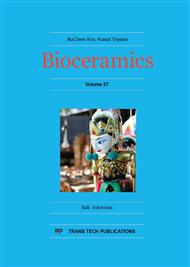[1]
S. Jebahi, M. Saoudi, R. Badraoui, T. Rebai, H. Oudadesse, Z. Ellouz, H. Keskese, A. E1. Feki, H. El Feki, Biologic Response to Carbonated Hydroxyapatite Associated with Orthopedic Device: Experimental Study in a Rabbit Model, Korean J Pathol. 46 (2012).
DOI: 10.4132/koreanjpathol.2012.46.1.48
Google Scholar
[2]
J.W. Park, J.H. Jang, S.R. Bae, C.H. An, J.Y. Suh, Bone formation with various bone graft substitutes in critical-sized rat calvarial defec, Clin Oral Implants Res. 20 (2009) 372–378.
DOI: 10.1111/j.1600-0501.2008.01602.x
Google Scholar
[3]
A. Grandjean-Laquerriere, P. Laquerriere, E. Jallot, J.M. Nedelec, M. Guenounou, D. Laurent-Maquin, T.M. Phillips, Influence of the zinc concentration of sol–gel derived zinc substituted hydroxyapatite on cytokine production by human monocytes in vitro, Biomaterials. 27 (2006).
DOI: 10.1016/j.biomaterials.2006.01.024
Google Scholar
[4]
R.F.B. Resende, G.V.O. Fernandes, S.R.A. Santos, A.M. Rossi, I. Lima, J.M. Granjeiro, M Calasans-Maia, Long-term biocompatibility evaluation of 0. 5 % zinc containing hydroxyapatite in rabbits, J Mater Sci Mater Med. 24 (2013) 1455–1463.
DOI: 10.1007/s10856-013-4865-x
Google Scholar
[5]
H.B. Valiense, A.T.N.N. Alves, E. Mavropoulus, M. Tanaka, A.M. Rossi, M. Barreto, J.M. Granjeiro, M.D. Calasans-Maia, In vitro and in vivo evaluation of strontium-containing nanostructured carbonated hydroxyapatite/sodium alginate for sinus lift in rabbits, J Biomed Mater Res Part B. 1 (2015).
DOI: 10.1002/jbm.b.33392
Google Scholar
[6]
M.D. Calasans-Maia, J.A. Calasans-Maia, S. Santos, E. Mavropoulos, M. Farina, I. Lima, R.T. Lopes, A. Rossi, J.M. Granjeiro, Short-term in vivo evaluation of zinc-containing calcium phosphate using a normalized procedure, Mater Sci Eng C. 41 (2014).
DOI: 10.1016/j.msec.2014.04.054
Google Scholar
[7]
K . Sunouchi, K. Tsuru, M. Maruta, G. Kawachi, S. Matsuya, Y. Terada, K. Ishikawa, Fabrication of solid and hollow carbonate apatite microspheres as bone substitutes using calcite microspheres as a precursor, Dent Mater J. 31 (2012) 549-57.
DOI: 10.4012/dmj.2011-253
Google Scholar
[8]
E. Mavropoulos, M. Hausen, A.M. Costa, S.R. Albuquerque, G.G. Alves, J.M. Granjeiro, A.M. Rossi, Biocompatibility of carbonated hydroxyapatite nanoparticles with Different crystallinities, Key Eng. Mater. 493-494 (2012) 331-336.
DOI: 10.4028/www.scientific.net/kem.493-494.331
Google Scholar
[9]
J. Barralet, S. Best, W. Bonfield, Carbonate substitution in precipitated hydroxyapatite: an investigation into the effects of reaction temperature and bicarbonate ion concentration, J Biomed Mater Res. 41 (1998) 79-86.
DOI: 10.1002/(sici)1097-4636(199807)41:1<79::aid-jbm10>3.0.co;2-c
Google Scholar
[10]
H.B. Valiense, G.V.O. Fernandes, B.S. Moura, J. A . Calasans-Maia, A.T.N.N. Alves, A.M. Rossi, J.M. Granjeiro, M.D. Calasans-Maia, Effect of carbonate-apatite on bone repair in non-critical size defect of rat calvaria, Key Eng Mater. 493 (2012).
DOI: 10.4028/www.scientific.net/kem.493-494.258
Google Scholar
[11]
F. Miyaji, Y. Kono, Y. Suyama, Formation and structure of zinc-substituted calcium hydroxyapatite, Mater Res Bull. 40 (2005) 209–220.
DOI: 10.1016/j.materresbull.2004.10.020
Google Scholar
[12]
Y. Tang, H.C. Chappell, M.T. Dove, R.J. Reeder, Y.J. Lee, Zinc incorporation into hydroxylapatite, J Biomed Mater Res Part B. 90 (2009) 886-893.
Google Scholar
[13]
K.A. Gross, L. Komarovska, A. Viksna, Efficient zinc incorporation in hydroxyapatite through crystallization of an amorphous phase could extend the properties of zinc apatites, J Aust Ceram Soc. 49 (2013) 129–135.
Google Scholar
[30]
T.J. Webster, C. Ergun, R.H. Doremus, R. Bizios, Hydroxyapatite with substituted magnesium, zinc, cadmium, and yttrium. II: Mechanisms of osteoblast adhesion, J. Biomed. Mater. Res. 59 (2002) 312–317.
DOI: 10.1002/jbm.1247
Google Scholar
[14]
E. Mavropoulos, M.E. Rocha Leão, M.H.P. Silva, A.M. Rossi, Hydroxyapatite-alginate composite for lead removal in artificial gastric fluid, J Mater Res. 22 (2007) 3371-7.
DOI: 10.1557/jmr.2007.0419
Google Scholar
[15]
ISO 10993-6: 2007 – Biological evaluation of medical devices - Part 6: Tests for local effects after implantation.
DOI: 10.2345/9781570206689.ch1
Google Scholar
[16]
S. Liao, F. Watari, G. Xu, M. Ngiam, S. Ramakrishna, C.K. Chan, Morphological effects of variant carbonates in biomimetic hydroxyapatite, Mat Letters. 61 (2007) 3624–28.
DOI: 10.1016/j.matlet.2006.12.007
Google Scholar
[17]
T.B. Schnaider, C. Souza, Aspectos Éticos da Experimentação Animal, Rev Bras Anestesiol. 53 (2003) 278 – 285.
DOI: 10.1590/s0034-70942003000200014
Google Scholar
[18]
V.S. Komlev, I.V. Fadeeva ,N.A. Gurinb, E.S. Kovaleva, V.V. Smirnov, N.A. Gurinb, S.M. Barinov, Effect of the concentration of carbonate groups in a carbonate hydroxyapatite ceramic on its in vivo behavior, Inorganic Materials. 45 (2009) 329–334.
DOI: 10.1134/s0020168509030194
Google Scholar
[19]
C.T. Zaman, A. Takeuchi, S. Matsuya, Q.H.M.S. Zaman, K. Ishikawa, Fabrication of B-type carbonate apatite blocks by the phosphorization of free-molding gypsum-calcite composite, Dent Mater J. 27 (2008) 710-715.
DOI: 10.4012/dmj.27.710
Google Scholar
[20]
J.M. Anderson, A. Rodriguez, D.T. Chang, Foreign body reaction to biomaterials. Semin Immunol. 20 (2008) 86–100.
Google Scholar
[21]
W.F. Zambuzzi, R.C.D. Oliveira, F.L. Pereira, T.M. Cestari, R. Taga, J.M. Granjeiro, Rat subcutaneous tissue response to macrogranular porous anorganic bovine bone graft, Braz Dent J. 17 (2006) 274-278.
DOI: 10.1590/s0103-64402006000400002
Google Scholar
[22]
M. Calasans-Maia, A.M. Rossi, E.P. Dias, S.R.A. Santo, F. Áscoli, J.M. Granjeiro, Stimulatory effect on osseous repair of zinc-substituted hydroxyapatite: histological study in Rabbit's Tibia, Key Eng Mat. 361-363 (2008) 1269-1272.
DOI: 10.4028/www.scientific.net/kem.361-363.1269
Google Scholar


